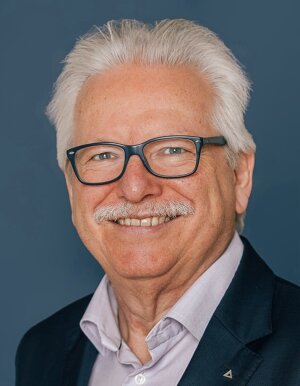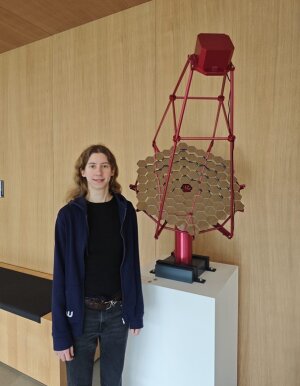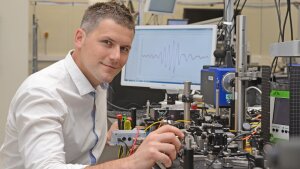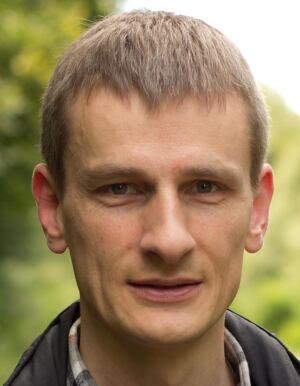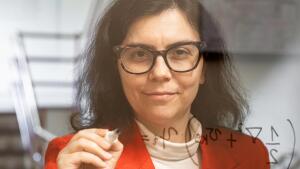Meldung vom:
Das Physikalische Kolloquium findet, wenn nicht anders angegeben, jeweils um 16:15 Uhr im Hörsaal 1 Abbeanum, Fröbelstieg 1 statt. Die Kolloquien im Hörsaal 1 Abbeanum können auch im Live-Stream verfolgt werden (hierExterner Link).
-
20. Oktober 2025
Mehr erfahrenProf. Dr. Günther Hasinger
Foto: privatProf. Dr. Günther Hasinger
Deutsches Zentrum für Astrophysik, Technische Universität Dresden, DESY ZeuthenCosmic Multimessenger Signals and the German Center for Astrophysics
The addition of gravitational wave measurements to the classical electromagnetic astronomy has opened a vast new area of exciting scientific studies – bringing sound to the cosmic movies. In addition, other information carriers like extreme energy cosmic rays, neutrinos, and even whole stellar systems can be used to derive physical information about the dark sector of the Universe. This field is dominated by the ecosystem of compact objects, in particular neutron stars and black holes of all sizes. The presentation reviews some of the most exciting recent developments in this field. This is the scientific arena for the German Center for Astrophysics (Deutsches Zentrum für Astrophysik – DZA), which aims to become one of the largest centers of multimessenger astrophysics in the world. Combining astrophysics, technology development and data science in an integrated approach, the center aims to have a transformative effect on the region in central Europe.
-
10. November 2025
Mehr erfahrenDr. Alison Mitchell
Foto: privatDr. Alison Mitchell
FAU Erlangen-NürnbergGalactic gamma-ray astronomy: novae, supernova remnants and pulsar wind nebulae
Astrophysical gamma-rays at photon energies above a few GeV are produced by non-thermal processes involving cosmic ray interactions. These cosmic rays are accelerated to high energies within our galaxy at astrophysical shocks, which arise in various environments. In this talk, I will give a brief introduction to gamma-ray astronomy and highlight examples of different source classes. Supernova remnants and pulsar wind nebulae are among the most numerous and powerful of known galactic gamma-ray emitters, reaching photon energies up to ~PeV. Gamma-ray emission from Novae, however, is transient in nature and reaches energies up to ~TeV. These maximum energies were found in 2021-2022, and I will place particular emphasis on recent results and future directions in this talk.
-
17. November 2025
Mehr erfahrenProf. Dr. Ioachim Pupeza
Foto: privatProf. Dr. Ioachim Pupeza
Leibniz-Institut für Photonische TechnologienResearch at the Laboratory for Lightwave Metrology
The outstanding control over the individual oscillations of the electromagnetic field of light, afforded by optical-phase-stabilized modelocked laser systems, has enabled manifold breakthroughs in science and technology. This talk will give an overview over the contributions of our research group to this field.
We will first address electric-field-resolved spectroscopy (FRS) in the infrared (IR) molecular fingerprint region [1]. Trains of few-cycle mid-IR pulses with identically repeating optical waveforms can be obtained via intrapulse difference-frequency generation driven by powerful, ultrashort near-IR laser pulses in suitable nonlinear crystals. Employing electro-optic sampling [2] to record their transient electric fields confirms the temporal reproducibility of these waveforms down to the (sub-)attosecond range [3]. In addition, electro-optic sampling affords a combination of detection sensitivity, linear dynamic range and bandwidth unprecedented in molecular spectroscopy [4]. These results constitute crucial steps toward infrared (non-)linear spectroscopy of solids, liquids, and gases at the ultimate limits set by the nature of light. In particular, we will address biomedical applications of these spectroscopic techniques which are currently being prepared in our group, including high-throughput infrared flow cytometry and breath analysis by infrared FRS at the intensive-care unit.
The second part of the talk will survey our work in the field of femtosecond enhancement cavities (EC). ECs are passive optical resonators, in which the power of laser light can be increased by several orders of magnitude by means of interferometric coupling. This technique is used for manifold purposes, reaching from high-sensitivity molecular spectroscopy, over high-power cavity-enhanced nonlinear optics to the realization of compact sources of high-photon-energy coherent x-rays via inverse Compton scattering. We will report on the power scaling of pulsed enhancement cavities to the multi-MW regime [5], the generation of temporal dissipative EC solitons [6], and applications of high-finesse ECs in FRS of gases [7].
[1] I. Pupeza, M. Huber, M. Trubetskov, W. Schweinberger, S. A. Hussain, C. Hofer, K. Fritsch, M. Poetzlberger, L. Vamos, E. Fill, T. Amotchkina, K. V. Kepesidis, A. Apolonski, N. Karpowicz, V. Pervak, O. Pronin, F. Fleischmann, A. Azzeer, M. Žigman, and F. Krausz, "Field-resolved infrared spectroscopy of biological systems," Nature 577, 52–59 (2020).
[2] I.-C. Benea-Chelmus, J. Faist, A. Leitenstorfer, A. S. Moskalenko, I. Pupeza, D. V. Seletskiy, and K. L. Vodopyanov, "Electro-optic sampling of classical and quantum light," Optica 12, 546 (2025).
[3] S. A. Hussain, C. Hofer, M. Högner, W. Schweinberger, T. Buberl, D. Bausch, M. Huber, F. Krausz, and I. Pupeza, "Sub-attosecond-precision optical-waveform stability measurements using electro-optic sampling," Sci Rep 14, 20869 (2024).
[4] C. Hofer, D. Bausch, L. Fürst, Z. Wei, M. Högner, T. P. Butler, M. Gebhardt, T. Heuermann, C. Gaida, K. S. Maiti, M. Huber, E. Fill, J. Limpert, F. Krausz, N. Karpowicz, and I. Pupeza, "Linear field-resolved spectroscopy approaching ultimate detection sensitivity," Opt. Express 33, 1 (2025).
[5] H. Carstens, N. Lilienfein, S. Holzberger, C. Jocher, T. Eidam, J. Limpert, A. Tünnermann, J. Weitenberg, D. C. Yost, A. Alghamdi, Z. Alahmed, A. Azzeer, A. Apolonski, E. Fill, F. Krausz, and I. Pupeza, "Megawatt-scale average-power ultrashort pulses in an enhancement cavity," Optics Letters 39, 2595 (2014).
[6] N. Lilienfein, C. Hofer, M. Högner, T. Saule, M. Trubetskov, V. Pervak, E. Fill, C. Riek, A. Leitenstorfer, J. Limpert, F. Krausz, and I. Pupeza, "Temporal solitons in free-space femtosecond enhancement cavities," Nature Photon 13, 214–218 (2019).
[7] P. Sulzer, M. Högner, A.-K. Raab, L. Fürst, E. Fill, D. Gerz, C. Hofer, L. Voronina, and I. Pupeza, "Cavity-enhanced field-resolved spectroscopy," Nat. Photon. 16, 692–697 (2022). -
8. Dezember 2025
Mehr erfahrenDr. Friedrich König
Foto: privatDr. Friedrich König
St. Andrews UniversityAnalogue gravity experiments with light in optical fibres
Analogue gravity aims to mimic physical processes that occur in the interplay between general relativity and field theory in a controlled laboratory environment. The goal is to gain insights into phenomena that are hard or impossible to observe in a purely gravitational context, i.e. in astrophysics. These are in particular situations of strong gravitational interactions, important quantum effects, or extreme length scales. In this talk I will describe how ultrashort optical pulses in fibres can generate an analogue of the event horizon and lead to the observation of the analogue Hawking effect [1]. In another approach, wave emission from the light ring of a black hole, as observed in the LIGO collaboration, can be modelled with a fibre optical analogue [2].
[1] Philbin et al., Science 319,1367-1370 (2008).
[2] Burgess et al.. Phys. Rev. Lett. 132, 053802 (2024). -
26. Januar 2026
Mehr erfahrenProf. Dr. Caterina Cocchi
Foto: privatProf. Dr. Caterina Cocchi
Institut für Festkörpertheorie und -Optik, Friedrich-Schiller-Universität JenaNeugier als Antrieb, Quantenmechanik und Supercomputer als Werkzeuge: Die Materialien der Zukunft beleuchtet
Die Entwicklung effizienter Solarzellen, leistungsfähigerer Batterien und sauberer chemischer Prozesse – kurz gesagt, die Schaffung nachhaltiger Energieversorgung – ist eine der größten Herausforderungen des 21. Jahrhunderts. Dieser Fortschritt hängt maßgeblich von der Entdeckung neuer Materialien und der drastischen Verbesserung bekannter Substanzen ab. Über Jahrzehnte hinweg war die Materialentwicklung jedoch ein langsamer und kostspieliger Prozess. Heute, im Zeitalter der Künstlichen Intelligenz, können wir die Leistungsfähigkeit von Computern und Daten nutzen, um ein virtuelles Labor zu errichten. Dies erlaubt uns, eine immense Zahl von Systemen und Kombinationen zu erforschen, die noch vor wenigen Jahrzehnten undenkbar waren. Basierend auf den fundamentalen Gesetzen der Quantenmechanik und mithilfe modernster Supercomputer können wir die exakten Eigenschaften neuer Substanzen Atom für Atom simulieren und dadurch deren optimales Design und ihre Synthese vorhersagen. Unser vorrangiges Ziel ist es, zu verstehen, wie strukturelle oder chemische Veränderungen die Wechselwirkung von Materialien mit elektromagnetischer Strahlung (z.B. mit sichtbarem Licht) beeinflussen.
In dieser Vorlesung stelle ich die computergestützten Ansätze vor, die es uns ermöglichen, die Materialien von morgen zu entdecken und zu verstehen. Ich präsentiere hierzu aussagekräftige Beispiele aus unserer Forschung, darunter Materialien zur Energiespeicherung wie Metall-Organische Gerüstverbindungen, deren Erfinder im Jahr 2025 mit dem Nobelpreis für Chemie ausgezeichnet wurden, sowie weitere innovative Materialsysteme. Abschließend zeige ich auf, wie wir Künstliche Intelligenz verantwortungsvoll nutzen können (und sollten), um die menschliche Intelligenz zu stärken – damit wir neugierig, optimistisch und vor allem menschlich bleiben.
